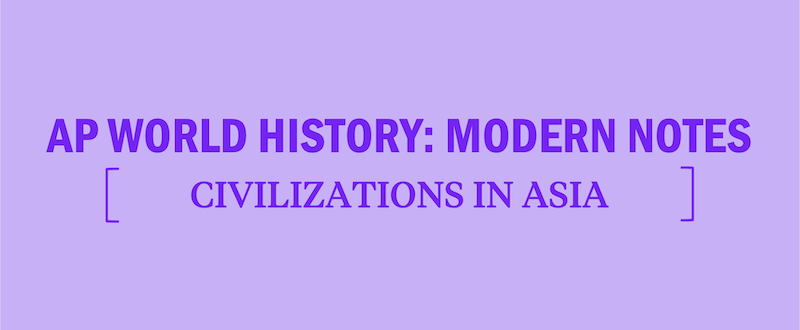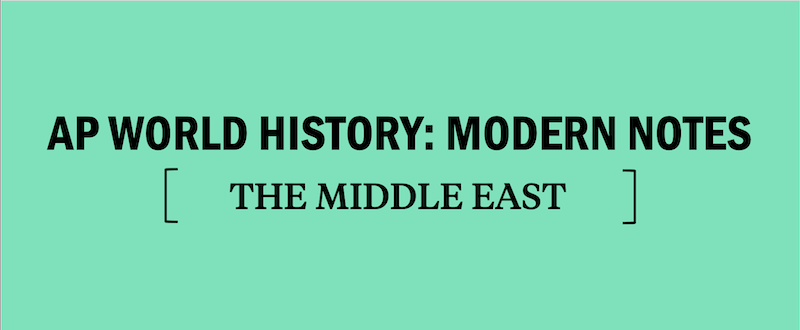Civilizations in Asia — AP World History: Modern
Having a solid understanding of civilizations in Asia will set you up for success on the AP World History: Modern Exam. Read on for a summary of the major ancient Asian civilizations you’ll need to know for the AP World History test.
Table of Contents:
Chinese Empire
Commonalities Across Chinese Empire Dynasties
A succession of different dynasties ruled China all through its history until the 1912 proclamation of the Republic of China. Three dynasties are of note in this period: the Song, Yuan, and Ming. The latter two will be discussed later in this chapter along with the Mongols, due to the involvement of the Mongols in the development of these dynasties. Certain elements are common to all three Chinese dynasties.
First, there is the Mandate of Heaven, an ancient Chinese concept stating that the right to rule was granted by the heavens. Because this power was divinely given, there was a direct connection between ruler and the heavens. However, if justice and order were not maintained, then the mandate could be revoked. Events such as floods, earthquakes, and peasant rebellions were indications from the heavens that the end neared for a dynasty.
Second, there is the imperial bureaucracy and the civil service examination system. By the time of the Song, the exam allowed for the entry of gentry and commoners to the bureaucracy.
Third, there is the Grand Canal, an economically vital series of waterways that linked the Yellow and Yangtze Rivers. This canal, the world’s longest, connected the fertile Huang He River to the highly populated cities in the north, allowing grain to be shipped easily. Farmers also took advantage of the Grand Canal’s complex irrigation networks and improved road networks; accordingly, the increased food supply facilitated population growth. Maintaining and occasionally expanding the Grand Canal was a vital duty of the Chinese imperial state.
Fourth, Neo-Confucianism was at the forefront of Chinese philosophy and was also influential in Japan and Korea. Delegations from the “outside,” such as Japan or Siam (present-day Thailand), had to show great deference to the Chinese emperor in his presence with the kowtow, a prostrate bow during which one touches one’s head to the ground multiple times. This symbolized the Chinese perception that they were superior to all foreigners.
Song Dynasty
The Song Dynasty, lasting from approximately 960-1279, brought about huge improvements in government, technology, and cultural development.
Song Dynasty Political Development
The founding of the Song Dynasty is traditionally dated to 960, but it was not until 979 that it had reestablished centralized control over China, ending the “Five Dynasties and Ten Kingdoms” period. The Song Dynasty deemphasized a military approach to security; instead, it reestablished the tribute system with its nomad neighbors, in which the Chinese provided nomads with gifts in exchange for peace. Despite this system, peace did not endure. The Song’s scholar-controlled army was often ineffective, and an excess of paper money in circulation caused inflation. Thus, the Song can be divided into two periods: the Northern Song (960–1127) and the Southern Song (1127–1279).
By 1126, China had lost the northern half of the empire to the semi-nomadic Jurchen, also known as the Jin Dynasty. The Song imperial court relocated the capital to Lin’an (present-day Hangzhou), south of the Yangtze River. Despite this defeat, the Southern Song held out against both the Jurchen and later the Mongols for decades. However, military threats from the north continued, and finally the most powerful of all northern groups invaded, absorbing the Song Dynasty into the new Mongol Empire in the thirteenth century.
Song Dynasty Economic and Technological Development
The economic revolution, which began under the Tang Dynasty, continued under Song rule. Fol- lowing Vietnamese agricultural practices, Chinese farmers began to cultivate champa rice, which improved crop yields. The population continued to increase, until it reached 115 million people in 1200 (as compared to 45 million people in 600). The earliest joint-stock companies developed in Song China, as investors sought fortunes in domestic and international shipping.
Several technological developments occurred. The first gunpowder weapons were developed by the Song. Iron and copper production grew massively. The capital of Kaifeng became a manufacturing center for cannons, movable type printing, water-powered mills, looms, and high-quality porcelain. After the Song lost control of Northern China, the Southern Song established their capital at Hangzhou, and commerce soared there as well. Ocean trade with East Africa, Southeast Asia, India, and Persia grew, especially due to naval innovations such as cotton sails and the magnetic compass. Because trade was so successful, copper supplies dwindled; paper currency and letters of credit, known as flying cash, emerged as forms of monetary compensation.
Song Dynasty Cultural Development
The civil service exam system retained great prominence during Song rule. It checked the power of the landed aristocracy and fostered the development of a powerful elite known as the scholar-gentry. Ceramics, painting, and sculpture grew in prominence during the Song Dynasty, as did poetry. The spread of gunpowder resulted in the development of fireworks. Buddhism declined as Neo-Confucianism rose in popularity.
Learn more about the history of China from our Chinese Empire Notes.
Korea
Korean history can be divided into two dynasties for much of world history: the Goryeo Dynasty (918–1392) and the Joseon Dynasty (1392–1897). The Goryeo unified the Korean Peninsula into one political body; the modern name of Korea is derived from Goryeo. Ruled by families from the military class, Goryeo notably resisted conquest by the Mongols for nearly three decades, until it eventually pledged allegiance to the Mongols as a client. The royal family began to intermarry with Mongol princesses from the Yuan Dynasty. Weakened by decades of warfare and Mongol influence in their government, the Goryeo were overthrown and the Joseon Dynasty was established.
Japan
Japanese Political Development
Japan’s geography as a group of islands led to the development of small, independent communities. In the Heian Period (794–1185), the Japanese emperor installed the new capital of Heian (modern-day Kyoto). During this era, the weakness of Japan’s centralized government led local aristocrats to recruit samurai. These warriors followed their lord’s orders and defended his interests, and they developed a strict warrior code called bushido (“the way of the warrior”).
After several centuries of civil conflicts, a Japanese noble, Minamoto no Yoritomo, created a form of feudal military government. Under this Kamakura shogunate (1192–1333), the emperor became a symbolic figurehead, and the shogun, the supreme military general, controlled a centralized military government. The shogun divided Japanese land into regional feudal fiefdoms based on military power. Regional military leaders called daimyo led groups of samurai warriors. When the Mongols attempted to invade Japan in the thirteenth century, they encountered this military and political system.
Japanese Economic Development
Japan was a predominantly agrarian society with an artisan class of weavers, carpenters, and iron-workers. Trade, which focused on markets in larger towns and foreign exchange with Korea and China, developed during the Kamakura Period.
Most Japanese people were peasants, who worked on land owned by a lord or by a Buddhist monastery. Though their freedom was limited, peasants could keep what remained of their harvest after they paid their tax quota. Those unable to pay became landless laborers known as genin (“low person”), who could be bought and sold with the land. As serfs, they performed jobs such as burying the dead or curing leather; eventually, these jobs would be associated with the burakumin outcast group.
Japanese Cultural Development
Although Shintoism remained a significant force in Japan, its society also welcomed Chinese and Korean influences. The Japanese people adopted Confucianism and Buddhism, as well as Chinese technology and script. Japan also developed its own version of Buddhism known as Zen Buddhism, which added a strong aesthetic dimension.
In early Japanese society, women could inherit or own land. Over time, however, women lost much of their legal and social power. Many women, however, such as Murasaki Shikibu, created literary works, including her famous novel The Tale of Genji.
Learn more about the Japanese Empire from our History of Japan Notes.






